Everyone in the prepping community gets around to talking about bug out bags at one time or another. I’ve done it myself. There are no shortage of reasons why we all need to have a bug out plan and having a good, well-stocked bug out bag is an integral part of that plan.
But I’ve discovered something through the years. That is, one bug out bag just really isn’t enough. It’s not enough because I don’t just have one situation I am likely to face. Survival scenarios don’t work just like we expect. When I say that, I’m specifically thinking that we’re probably not going to be sitting in our home, with our family all present, just waiting for something to happen. Chances are much higher that we’ll be away from home, perhaps at work, perhaps elsewhere.
That single thought made me realize that one bug out bag wasn’t enough to meet my needs. Our bug out bags are built with the idea of using them when we leave our homes, due to a disaster. That means we won’t have it with us when we go to work every day. So it’s not going to help us get home. That’s actually for the best, because if we did have it at work and used it to help us get home, it probably wouldn’t be ready to be used for bugging out. We’ll have used some of what’s in it.
So I don’t count on my bug out bag to get home. Rather, I have a get home bag to do that; let’s call it bug out bag number two. I keep it in my office, rather than the car, so that it is ready to use if an emergency happens while I’m at work. After all, I might not have my car with me.
Then there are those times when I’m away from home, but I’m not at work. In pretty much all of those cases, I can count on having either my or my wife’s car with me. That’s a good thing too, as I really don’t want to walk around all the time with a bug out bag on my back. Both cars have emergency kits, which include a get home bag, as well as other car-related emergency equipment. That’s bug out bag number three.
If I had a cabin in the woods, which I had established as my survival retreat, I would also have a bug out bag there, just in case I had to bug out from that location. But since I don’t have that cabin yet (hopefully one day), I still only have three bug out bags.
Another way I might have four is if I had summer and winter bug out bags. In some parts of the country, that would make sense, as the gear you need for survival in the winter is considerably different from the gear you need to survive in the summer. Basically, you need a whole lot more to keep you warm. But where I live, that’s not much of an issue, so I don’t have seasonal bug out bags. Rather, I make a few changes to my bug out bag every spring and fall, preparing it for summer or winter. Those are basically clothing changes.
My Main Bug Out Bag #1
My main bug out bag is intended to be the one I’ll use, if I am forced to abandon my home in a time of disaster or crisis. As such, I try to keep it as complete as possible, avoiding using it or the items in it for any other needs, regardless of what they are.
Compared to many people, my bug out bag is heavy on survival gear. That’s because I’m not planning on going to a FEMA shelter or any other kind of shelter for that matter. I recognize the possibility that I might need to survive out in the wild and am prepared for it. However, it really isn’t intended to be complete enough that I could just turn my back on society and walk away. I would need much more, in several key categories, to do that.
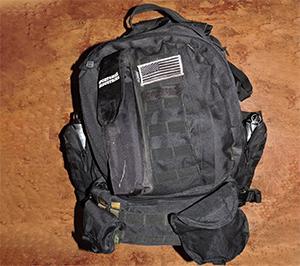
I’m using a tactical pack for this one, although I normally don’t recommend using tactical packs. The problem with them is that they are too obvious. Others looking at it will likely think that you’re ready for anything, if you’re carrying a pack like this. You’re better off using a standard backpacking pack, for that reason.
So, if that’s the case, why am I using a tactical pack with MOLLE straps? Because I had it. If I have to, I’ll throw a towel or other piece of fabric over it to camouflage it. In the mean time, the MOLLE straps give me the ability to tie things to the outside, increasing my carrying capacity.
This bag is mirrored by smaller bug out bags for every member of my family. While mine holds the majority of the tools and survival gear we’ll need, each family member carries food, clothing and basic survival gear. We have the option of adding sleeping bags to that, should we end up bugging out in cold weather.
As mentioned earlier, I go through my bug out bag twice a year, updating it for summer and winter. At that time, I check the contents, ensuring that it is all in good condition. Some food items might be replaced with fresh ones. New items might be added, as I am always looking to improve my bug out bag overall. The same happens with each family member’s bag.
So, what’s in this bag? Here’s a list, broken down by categories:
Shelter
- Ultra-light tarp (in black bag with lettering) for making a shelter
- Tough rescue blanket (the kind that won’t tear)
- Two rescue blankets
- Emergency tent (made from same material as rescue blanket)
- Two person emergency sleeping bag (made of the same material as rescue blankets)
- Two ponchos
- Roll of duct tape
- 100 feet of paracord
- Two tent stakes (while tent stakes can be whittled from sticks, these are useful for soft ground, where the regular stakes won’t hold)
- One change of rugged clothing
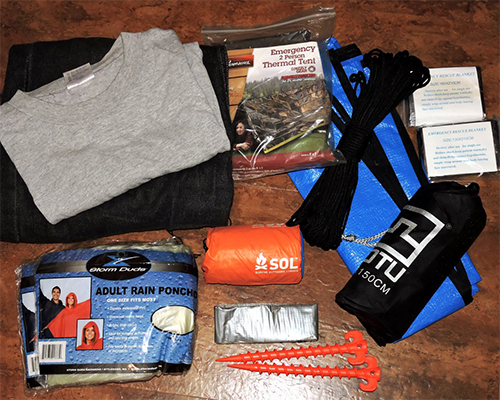
In addition to these items, I would be taking a seasonally appropriate coat, hat and gloves.
Food
- Jerky (for meat)
- Homemade dehydrated chili
- Ramen noodles
- Rice-a-Roni (removed from boxes and in plastic bags, so it will pack easier)
- Macaroni & cheese
- Backpacking butter
- Instant coffee
- Instant mashed potatoes
- Dried fruit
- Three kinds of granola bars
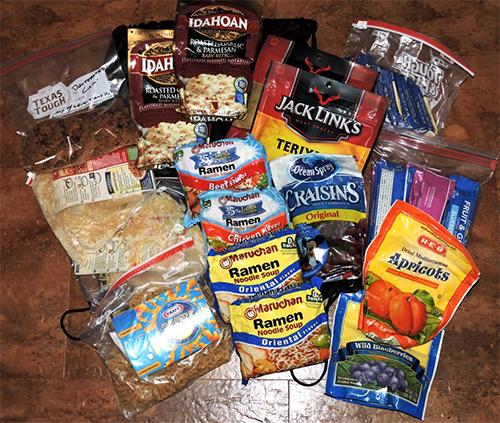
Please note that not everything is shown in this picture; I’ve merely included a representative sampling of the food that I carry. This bug out bag has enough food for two people, for five days.
Cooking Gear
- Folding camp stove (essentially a rocket stove) – allows me to cook, without building a fire pit
- Two aluminum water bottles – can be put in the fire
- Aluminum backpacking cookware set
- Two collapsible stainless steel cups
- Two plastic bowls
- Two sets of stainless steel cutlery
- P-38 can opener (not shown)
- Various spices
- Survival fishing kit, including automatic reels
Water Purification
- Sawyer portable bag-type, hollow-fiber water filtration system; good for 1 million gallons at 0.02 microns
- Lifestraw personal water filter (each family member needs one)
- WAPI (water pasteurization indicator) – lets you know when water reaches 160°F, the temperature at which all bacteria are killed
- Halzone water purification tablets
Related: How To Store 100 Gallons Of Water Using A WaterBOB
Fire Starting
- UDC Stormproof lighter (best survival lighter on the market)
- Stormproof matches
- Blastmatch
- Metal match
- Powdered magnesium (good tinder)
- Wetfire fire starting cubes (tinder) (I actually have a lot more than these three)
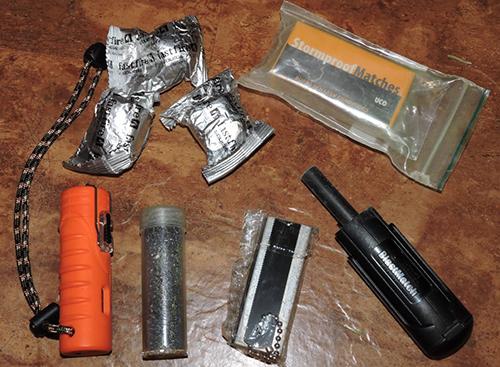
Any survival instructor will tell you that you need lots of redundancy in your fire starting methods. I have two primary and two secondary fire starters here.
Related: How to Make Firebricks (fire logs) and Wood Stove Logs for Free!
Personal Hygiene
- Roll of toilet paper
- Two toothbrushes w/toothpaste
- Soap
- Q-tips
- Deodorant
- Shampoo
- Antibacterial hand cleaner
- Comb
- Insect repellant
- Compressed towels (not shown)
- Sewing kit
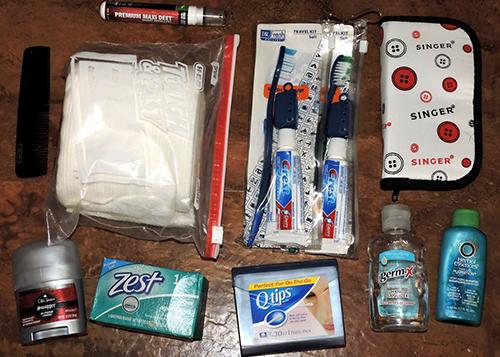
One thing that’s notoriously missing from this bug out bag is a first-aid kit. That’s because my intent is to take the first-aid kit that is included with bug out bag number three with me. I want it because it has more than I would otherwise put into a bug out bag.
Tools
- Manual chain saw
- Folding pruning saw
- Folding shovel/pick combination
- Camp hatchet
- Multitool
- Sheathe knife
- Knife sharpener
- Tactical light (high power)
- Headlamp (not shown)
- Spare batteries for tactical light and headlamp (not shown)
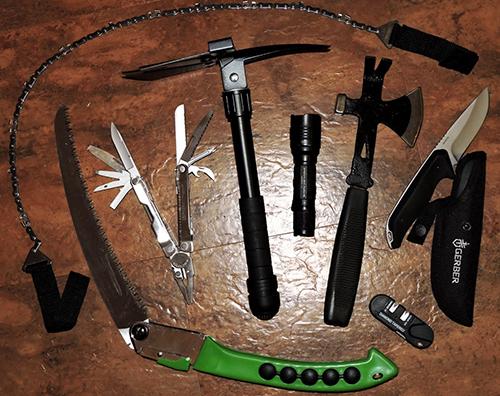
Having both a manual chain saw and a folding pruning saw is a bit redundant, but I have found that there are places where only one or the other will work, due to space limitations. The manual chain saw is small enough and light enough that I don’t mind carrying it as well.
Signaling
- Signaling mirror
- Whistle
- Waterproof note pad
- Mechanical pencil
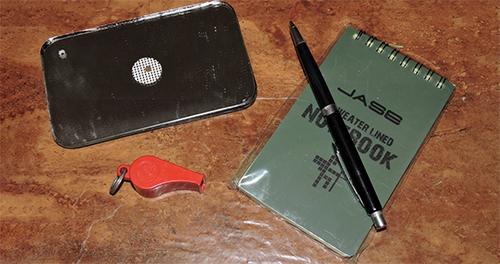
There are two items missing from this photo, a burner phone and a solar phone charger. When I went into the pack, both were broken; the phone by impact and the solar charger looks like the battery overheated. I will need to replace these two items.
Another thing that’s missing from this pack is any sort of weapons. That doesn’t mean that I’m not taking one with me, just that it isn’t in the pack. I will have my carry pistol, which I carry everyday, as well as one of my long guns.
My Get Home Bag #2
My get home bags (this one and the car bag) are living tool kits, used to deal with a variety of the vagrancies of life, even dealing with day-to-day problems. Should I find myself in the position where I need to use the contents, it’s really not a problem, as I just make sure that I replace it. That even goes for the food kept in these kits, which is used to help me control my blood sugar and then replenished as needed.
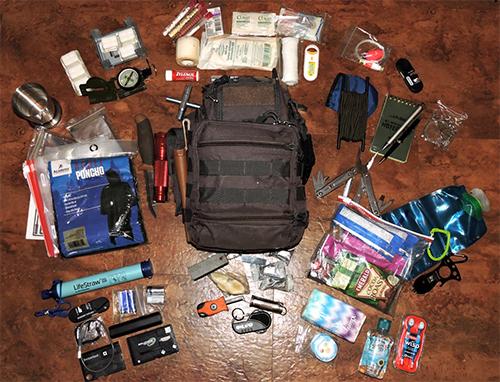
The bag itself is a Condor cross-body EDC Bag, made just for this sort of thing. It measures about 10”H x 12”T x 9”D filled. As it sits, there’s still a little bit of room in it, although I do have it fairly full.
Should it fill up and I need more space, the bag has MOLLE straps on the front and bottom, allowing me to add additional pockets. The MOLLE straps on the sides are where I’ve hung my sheathe knife, tactical flashlight (in a pouch), multi-tool and lighter (on a carabineer). Straps on the top will hold a light jacket securely while traveling.
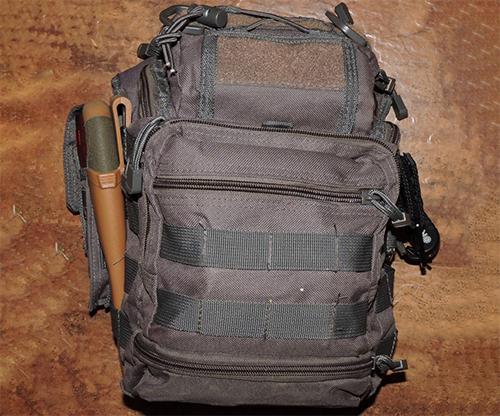
As these bags are intended to allow me to get home in a pinch, they are essentially super survival kits. There’s more survival gear in them than most people would put in a survival kit; but less than what I have in my main bug out bag. They also have much less food and don’t have a change of clothes.
Here are the things that are contained in my get home bag:
First Aid
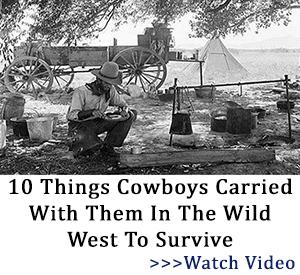 Abdominal bandage
Abdominal bandage- Knuckle bandages (in plastic bag)
- Adhesive strips (in plastic bag)
- Cohesive medical tape
- Stretchy gauze
- Neosporin (antiseptic cream)
- Insect repellent
- Alcohol wipes
- Steri-strips
- Tylenol/Ibuprofen
- 3 day supply of my personal medications
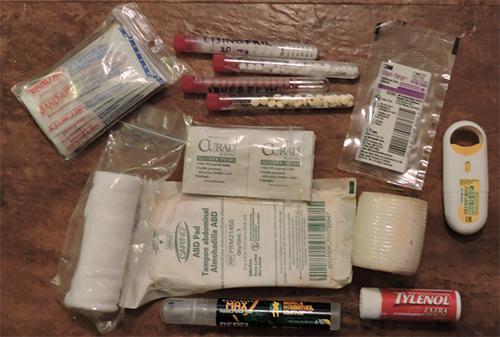
These items are carried in the top pocket for convenience.
Related: 5 First Aid Skills Every Senior Should Know
Personal Hygiene
- Kleenex
- Anti-bacterial hand cleaner
- One-use toothbrushes
- Deodorant
- 3 Compressed towels
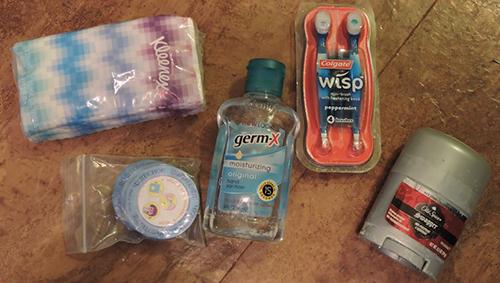
These items are carried in the front pocket.
Related: Toilet Paper Pills – The Best Invention You Didn’t Know Existed
Shelter
- 2 rescue blankets
- 20′ paracord
- 10 yd duct tape (not shown)
- Rain poncho (can be used as a tent)
- Collapsible hand fan (for cooling)
Related: Emergency Shelters When You Are On The Move
Food & Water
- Lifestraw water filter
- Collapsible water bottle
- Spare plastic bags – 4 (good for storing food and as extra water bottles)
- Esbit stove w/extra fuel (works to heat food, even when there isn’t any wood available)
- Spork
- Collapsible cup
- P-38 can opener (not shown)
- Snacks (jerky, granola bars, nuts)
- 2 – 12″ x 24″ heavy duty aluminum foil (not shown)
- Fishing kit (line, bobbers, weights and hooks)
Related: Cheap Foods That You Can Buy At A Mormon Cannery
Tools
- Flashlight
- Spare batteries (for flashlight & my EDC flashlight
- Sheathe knife
- Knife sharpener
- Multi-tool
- Wire saw
- Compass
- Lock pick set
- Pad of waterproof paper, w/ pen & pencil
- Hose bib key (opens commercial hose bibs, where there is no knob)
Electronics
- Phone charging battery
- Car cigarette lighter adapter (not shown)
- CR123 batteries (2)
- Hair bands (for use as rubber bands) (in bag)
- Paper clips & binder clips (in bag)
- Safety pins (in bag)
- Copies of my driver’s license and passport (not shown)
- Emergency contact phone number list (laminated) (not shown)
- Mini office
- Fresnel lens
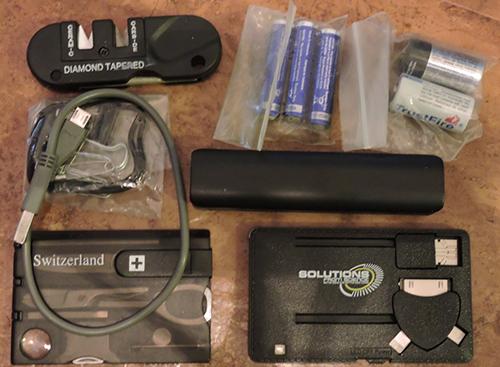
This is enough for me to survive for a number of days. I’ve gone into the woods with less than this and stayed for several days at a time. Of course, the resources that an urban situation offer to you are different than those you’ll find in the wild; so you’ll probably have to adjust your survival techniques a bit.
Related: Rescuing And Restoring Almost Dead Lead-Acid Batteries
My Car Bug Out Bag #3
My car bag consists of three parts. The first of these is essentially the same as my get home bag; the one I keep in my office. In fact, I built the two of them at the same time, ordering 3 of everything (there are two of these, as there’s one in my wife’s car too). That may seem a bit excessive; but by having the same gear in all these kits, I’m assured of having everything I’ll need. I’m also assured of being able to find it, as it is in stored in the same location in all three kits.
If you look carefully in the picture below, you can see the same sort of cross-body bag in the trunk of the car, behind the roll of blue paper towels.
The second part of this bag is intended to take care of problems which are specific to being in the car. It consists either of things I need to take care of automotive emergencies, or things that would help me survive in my car, at times I might find myself trapped in it, such as during a blizzard. In such a case, having extra rescue blankets is useful, to help keep the passenger compartment warm.
The third item is a trauma first-aid kit that I made to keep in my car. It is used not only for my own needs, but so that I have a first-aid kit to help others with. There have been a number of accidents where I was the first to arrive and offer assistance.
I’m only going to list the additional items here; those which are not in by get home bag:
Tools
While it may not be practical to keep an entire tool kit in the trunk of a car, I do keep a number of tools; basically enough to do most roadside repairs.
- Jack (not the one the vehicle came with) (not shown)
- Star wrench – for changing tires
- Jumper cables
- Gas can
- Water
- Vehicle fluids (not shown)
- Socket set
- Combination wrench set
- Reversible screwdriver
- Pliers
- Car jumpstart battery; useful for other battery-powered devices also
- Tow strap
- Emergency flashing lights (2)
- 30 foot steel cable with snap links (originally a dog lead, but useful for rescue operations)
- Heavy-duty collapsible shovel
- Machete
- Tarp
- Toilet paper
- Blue “shop towels” paper towels
- Hand degreaser
- Flashlights and headlamps (not shown)
- Various weapons (not shown)
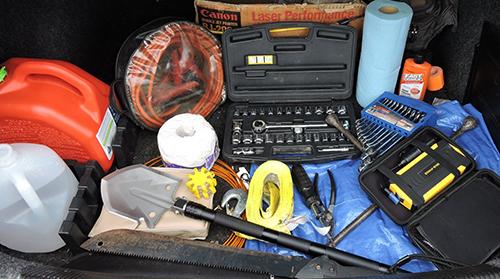
These items are specific to problems which might happen while traveling in a car. While they are often useful for other things as well, they were selected specifically with the idea of dealing with survival problems I might have while traveling in my car or bugging out in it.
Related: 13 Weird Survival Tools Every Prepper Should Stockpile
First-Aid
I have carried a first-aid kit in my car for years; long enough that I can’t even begin to count the number of times I’ve used it. Whether it was coming upon a car accident, someone getting hurt during a recreational event, job-related injuries or kids falling off a bike, this kit has often been the closest first-aid kit I’ve had available. The current iteration is built into a travel shave kit. I have a larger one at home, which is my primary survival first-aid kit.
Note: I’m going to go clockwise, starting in the lower left
- Adhesive cloth bandages
- Cloth fingertip bandages
- Cloth knuckle bandages
- Alcohol towelettes (for disinfecting)
- Tagaderm (for use in covering rashes, after putting on medicines)
- Snake bite and bee sting kit
- Israeli bandage
- Antibacterial hand cleaner
- Compressed gauze
- Elastic bandage (for sprains and for use with the splint below)
- Formable universal splint
(inside case, top down)
- Latex gloves
- Neosporin, a topical antibiotic
- Benzoin (helps promote adhesion of bandages)
- One-handed tourniquet
- Cohesive medical tape
- Sanitary napkins (make great bandages for large injuries)
- Abdominal bandages
- Surgical scissors
- Hemostats – for closing off bleeding blood vessels
Food
In addition to these items, I also keep a number of food items in my car’s trunk. I wrote about this earlier this year, in an article entitled “12 Foods I Keep in My Car at All Times.”
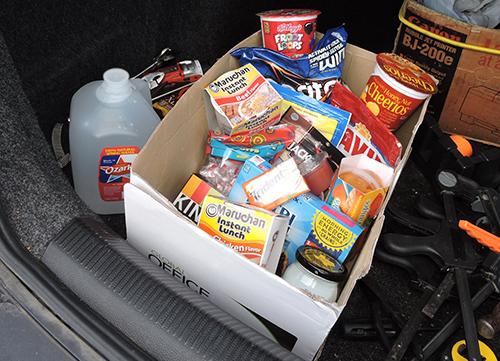
Although my car bug out bag is built around a bag identical to my office get home bag, I expect to augment it in the near future. I am working on a project truck, which will be my bug out vehicle. When I complete it, I will be expanding that kit, so that I have more in the truck, than I currently have in my bug out bag. Specifically, I’ll have some larger tools (pioneer tools), sleeping bags and a tent.
You may also like:
10 Awesome Food Ideas for Your Bug Out Bag
The U.S. Army’s Forgotten Food Miracle (Video) (Video)
The Bug-Out Vehicle That Can Literally Take You Anywhere You Want
7 EMP Proof Items for Your Bugout Bag

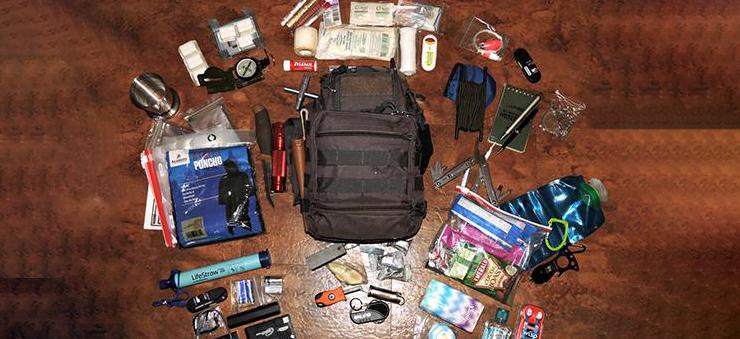
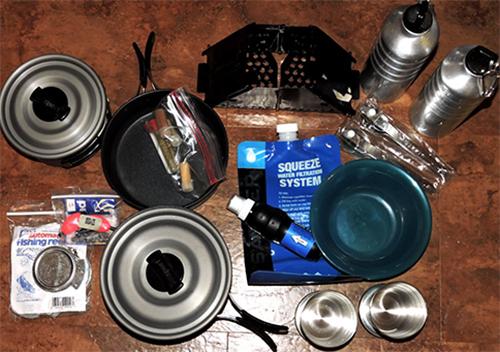
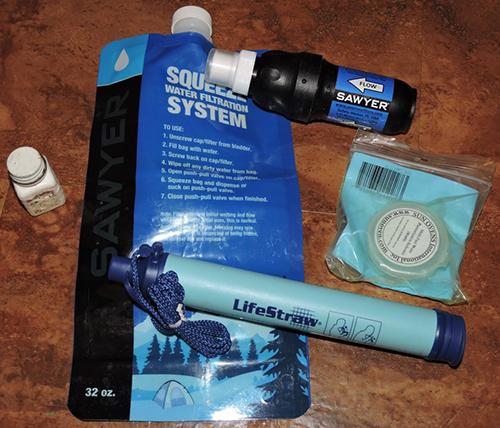
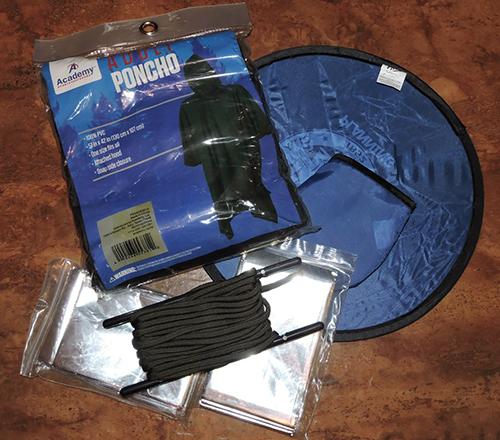
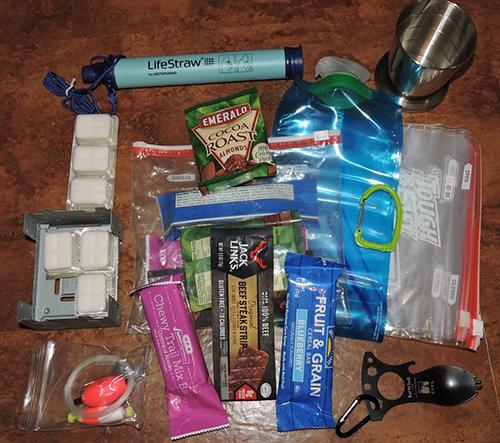
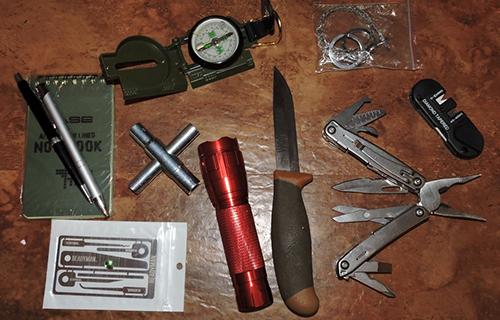
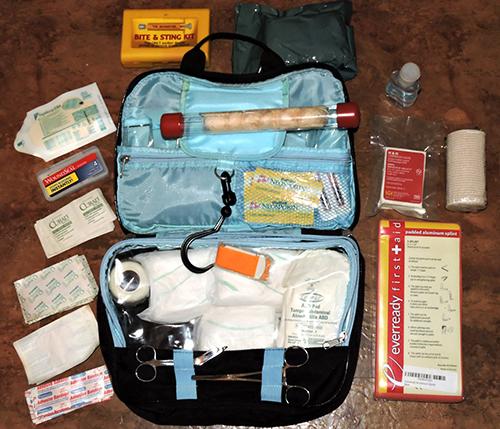














WOW… you certainly are prepared!!
Awesome bags and lists, Claude! Thanks for that, I steal all your ideas.
If I were to add one item to practically all of those bags, it would be SOCKS.
You can use socks for a lot of things. They help fill up bags in the (unlikely) situation you had spare room. They stuff in just about anywhere. They keep your feet dry. And you really can’t have too many.
Oh yeah. I put socks on my hiking stick handle when I use it as a support for my tarp. It keeps the stick from slipping and at the same time spreads out the area where the stick touches the tarp to decrease wear.
How do you fit all of that into each bag? That is a lot! I have a large bag but I can’t get everything to fit. Can you write an article on packing tips?
I’m right there with you, Cheri. I couldn’t fill all that into one bag, 3 bags, or 5 bags. I could fit all that in the back of my pickup truck. That’s it. So when people talk about bug out bag, that is a misnomer.
One survival blanket I highly recommend is called a “Blizzard Survival Blanket” manufactured in the U.K. It’s a multi-layer space blanket that is actually big enough to put an entire body inside and wrap up like a burito. Just went through a Wildness First Responder course and our night-time exercise was a mock plane crash in a snow storm. We packaged one patient in one. Our weather was snow, 25-28 F with 10-15 mph winds with 8 inches if snow on the ground. Asked the patient how the blanket did…warm and toasty! One tip, do not open the vacuum packed pouch until you actually need the blanket. Once fluffed out, it occupies 6-8 times the volume!
Thanks for sharing your bag designs!
Yeah they make a Great Weapon too, when You want to knock someone out that is trying to kill you with a knife or hunting you with a gun …
Your vehicle kit and mine are practically twins. Since I work out of my vehicle the gear blends in with the work equipment, and some of that serves double duty. I also included a fold up “Beach Buggy” which could be useful for carrying a lot of this gear should I have to leave the vehicle for any reason. I also have two fishing rods (taken down to save space) and a small tackle box that carries other essentials too. I also have an “office bag” that acts as my portable office with my laptop and information I need for work that is kept in a binder. My 3rd bag is my ‘necessary bag” that I take when not in my work vehicle. When my wife and I took a long road trip last year, all of this gear went with us. Good article!
Thank you! Unless I over look it, meds hou take. I was able to talk the lables off the old bottle when I got my refills. I carefully put the lable on a pice of card stock(any craft store carriers them & you can put several lables on on card). I trim around the card so I have lable separate so they are one behind the other. I either vaccym seal them together. Mine in one bag and my Hubby’s in another. I make two sets, one I carrie on me and one my Hubby carries on him. And putting them in either a vaccum bag or the freezer ziploc bag so they stay water proof.
Very comprehensive list. The only modifications I would make are with the fishing gear. Unless you have fished the waters on your way to wherever and are familiar with the “hot spots,” I would suggest that spending time fishing might wind up being a monumental waste of time.
I know that every prepper book talks about taking fishing gear. They all make fishing sound so easy. Just thread a lure on your line, toss it in and pretty soon you have a nice size fish on your line for dinner.
I have fished a bit and for every day where I caught enough fish to make what I thought would be a meal I spent two days either catching fish that would only be a light snack or nothing at all.
Perhaps I am just a lousy fisherman, but I think fishing is like going to Vegas. I have never met anyone who came back from Vegas and said, “Dang, I lost my ass in Vegas.”
Everybody “makes expenses.” Come on folks, Vegas wouldn’t exist if everybody who went there made the cost of the hotel and meals plus gas getting there.
I think fishing is much the same. Hardly ever hear somebody say, “I spent the whole d _ _ _ _ d day fishing, lost four lures and didn’t even get a nibble.”
I would rather carry extra rations than waste time fishing, especially if I am trying to reach a destination.
That said, there is one bit of fishing gear I might carry if I knew I were going to be passing water that was known to contain catchable fish, and that is a trot line. If I am going to be overnighting close to fishable waters, I would toss in the trot line and retrieve it the next morning. Total time spent 15 minutes max. If I have caught something, fine, spend some time cleaning it and cooking it before I depart for the day. If not, well, I haven’t wasted a lot of time on my journey trying to catch ghost fish.
You have to be guided by your own experience and knowledge of the routes you will be traveling. If you know that you will be passing by a lake where, each time you fished there and you are a regular, then fishing gear might well be a valuable addition to your get home or bug out bag.
If you are in SoCal and it is middle of May through end of October when all the streams and “rivers” are just damp sand with maybe a little trickle of sewage running down the middle — or any other similar area in the country — there are vast stretches of land in the U.S. where water is a fantasy — hauling a couple of fishing rods, reels and assorted jigs and lures is an unnecessary burden. You are better off carrying extra SOS ration bars and extra water.
As with all prepping, don’t over estimate your abilities. Prepper authorities speak of covering 25 miles a day with a full pack, avoiding hostiles as though it were nothing. They all talk about carrying fishing gear. I wonder how many of them have actually spent any time catching meaningful quantities of fish.
A prepper expert recently posted his bug out bag contents for three days. His total food allotment for three days was nine Cliff bars. He is planning on covering 25 miles a day on that. I used to use Cliff bars on my long distance bike rides for a quick energy boost. I am really familiar with them. A Cliff bar never exceeds 300 calories. Most of them run from 225 to 250 calories per bar. So our expert is going to hike with a pack while existing on 750 calories per day over a three day period. I e-mailed him and said I suspected that he had never actually done that and that his advice was reckless and dangerous to folks who were unknowing and might rely on his erroneous advice to their fatal detriment. He didn’t bother to reply. This is a guy who make a living advising people about survival.
When your life is on the line, you absolutely must analyze the advice you are given and see if it makes any sense. Try to be realistic about it.
How far can you really walk carrying 50 or 60 pounds on your back? Rod’s comment that he has a beach buggy to haul his gear is sensible. You can go a lot further and average better speed using a device to haul your gear than your back.
This article listed a lot of items that one might carry in a bug out bag. I think his main bug out bag is going to be too heavy for most of us to carry on our backs for any distance. He makes no mention of any carrying device to move his gear. I would suggest that a collapsible luggage cart in your vehicle is an important part of your get home gear.
Don’t be mislead by what you were able to do in the Sandbox twenty years ago. Or worse yet, in Vietnam fifty years ago.
You’re right about the fishing. I’m from Louisiana, the “Sportsman’s Paradise”, and it should really be called the “Locals’ Sportsman’s Paradise”, because if you’re not from there and know what water to go to– as well as where at on that water– you’re not likely to catch fish.
We all carry a 12-pack of what we call yoyo’s. These are just that, you pull out a few feet of line with a hook, bait it and tie the yoyo to a limb. When a crappie or catfish bites it, the yoyo rewinds, sets the hook, and there your fish hangs.
With 12 of those out over five or six hours, you’ll get some fish, probably.
Silver: That’s why if I travel to go fishing the first thing I do is check out the local guides and hire a guide. That is if I really want to catch fish. If I just want to drown bait, I can do that at the local lake a lot cheaper.
I have seen those yo-yo devices and thought they were just a device to separate a sucker fisherman from his dollars. Have you personally used them? Do they actually catch fish? If you hook into a large fish are they strong enough to keep it on the line, assuming you have used sturdy enough line on the reel.
With a trot line, I know if I use the 75 pound test line, unless I catch a couple of monster river cats, it is going to hold anything short of Moby Dick.
I keep a couple of these in my bags, works great for smaller fish.
You’re right about the Cliff bars! If all he has are 9 Cliff bars, they better each be tucked inside an MRE, if nothing else lol.
All the muscles in his legs will be cramped. His thought processes will be dulled. He will have trouble operating his water filter which will add to his problems and he will have trouble using his flint and steel to start a fire. He doesn’t use matches, he is too much of a wilderness man to be bothered with such modern devices. All that, of course, is provided he isn’t in a coma from highly depressed glucose levels in his system.
Left Coast Chuck, you are spot on as usual! Other uses for my poles would be for stringing perimeter alarm monofilament and getting wire in trees for antennas. I do carry enough kit to put together either bank or jug lines, depending on the situation. You are absolutely correct in that as we get older our abilities diminish, and if that is not accounted for you are very quickly in deep doo-doo.
I believe you have your head on straight buddy! Your comments nailed everything I was thinking. There is a little more stuff than I would attempt as I’ve always hiked/camp with minimal gear – normally 30lbs or less. I did a BSA adventure at Philmont BSA in New Mexico. 50 lb pack that we were required to carry damn near killed me in the mountains. Most we ever hiked in a day was 12-14 miles and that was ALL day with few breaks, so I know 25 miles with 50-60lbs would be quite a feat. Especially for us elders! Good comments – thanks!
Approximate total cost?
Don’t do it all at once! If you have been prepping for any amount of time, you already have most of this stuff. Just try to buy a few extra items each time you shop. Save up a few weeks to get the more expensive items.
In August, 2019, we were preparing to go to church. I had just gotten out of the shower. I was sitting in there living room when my phone rang. It was my neighbor across the street. She said your neighbor’s 80 acre property is on fire. I didn’t believe it. I stepped outside & all I saw was a small area of smoke. I ran inside to dress start grabbing things, animals, 2 go bags, etc. Threw everything into car. Hubby had gone to get other animals & cages for the chickens. We were able to get all but two chickens into cages. By now the smoke wasn’t just smoke. It was 8 foot tall blazes. We sat in our vehicles watching & I cried.
However, our to go bags allowed us to spend what time we had on getting animals safe. We have 40 acres & the wind was blowing toward our structures. I called the pastor & he prayed. When he was done & I looked at the fire, the wind had shifted to the north away from us. The fire burned 200 acres but the fire department was awesome. We didn’t lose anything.
So even though we didn’t plan on using our to go bags in this way, we were ready in a disaster.
I wrote about my bug out experiences after the SoCal fires two years ago. I don’t remember under which of Clyde’s headings I wrote them, but I wrote what happened during my fire bug out and then we all had a long dialog back and forth to amplify my original post.
At 0330 in the morning I was sure that my street and my home was going to undergo the scourge of wildfire. Fortunately, I was wrong, although the flames burned houses about 300 yards from my home to the ground.
If you didn’t read that post at the time, perhaps Claude will post what subject matter it appeared under if he remembers. I learned a lot about bugging out and tried to pass on lessons learned. While I didn’t think that I panicked, I didn’t exhibit stressed breathing or feel lost. I moved with deliberation and swiftness, yet overlooked very important items due to lack of foresight.
One thing I don’t think I mentioned, a 100 lumen light attached to your hat brim or strapped to your forehead is 100X better than the 1000 lumen flashlight in your hand. Yeah, you can hold it in your mouth but try issuing instructions to your family while looking for the deed to the house with the flashlight in your mouth. If you can do that you should go on stage. You’re better than Edgar Bergen.
For those of you who need to, better carry a several days worth of your essential medications; i.e. prostate pills so you can pee.
Anyone might also carry a chocolate bar in case a family member starts feeling low … great article – incredibly well thought out !
You are a lot tougher than me, l can’t carry all that stuff. My primary bag weighs about 30 pounds and I walk with it to keep my shoulders conditioned.
You didn’t mention a weapon and a basic load of ammunition. That will add weight. Body armor adds weight also if you plan on that.
I do carry a blowout kit for gun shot wounds. I have a long range walkie-talkie for comm.
I have a hydration bag on the back of my body armor. Water is heavy.
It is sometimes hard to separate wants from needs.
How far is it to get home with your get home bag? Suburbs are not a good place to be. They will be prime targets for looters looking for food. Roadblocks will be an issue if you travel by car, ambush points.
The increasing homeless population can be an issue, they are good opportunists. You could become a target there.
You need a plan, think it through. You need a place to go.
Good list for the bags. One thing I would add for the car bag is a way to relieve yourself. I’m thinking of those poor motorists who were stu k on the turnpike during the 1978 blizzard. Yeah you could probably squat by your car, but who’s gonna wanna do that when the snow is falling so thickly and winds are howling? The other thing I keep in my vehicle in colder weather is a pair of snowshoes. If I need to abandon my car and go over a lot of snow, they make it easier.
You are right about not wanting to relieve oneself outside when the weather is highly inclement. Having spent two weeks at the Marine Corps Cold Weather Training Battalion undergoing “training”, I can attest that you are strongly disinclined to expose your nether regions when the temps are hovering around zero during the day and considerably below that mark after the sun goes down. When we got back to San Onofre, besides dumping our two-week old underwear in the GI can, we then headed off and tried to move our bowels which had not moved for some considerable period of time.
I always carry a urinal bottle in the car. Sure, I can stand by the side of the road and relieve myself, but my wife is more reluctant to do the same, so many years ago even before I got into prepping, I bought a woman’s urinal bottle to store in the car in case of one of the interminable shutdowns of a freeway while we were on it.
A year ago a head-on collision happened just in front of us on the freeway. I didn’t stop but just keep on going. I didn’t really see the collision occur, so wasn’t a witness and of course, dozens of people pulled over, so lacking any really expert first aid training, I wasn’t going to do anything but add to the confusion at the site. I later learned that traffic was stopped in both directions for over three hours before it started moving again. I was about one minute from spending three hours stuck on the highway with no possible exit. You just never can tell. I didn’t see any reason for a head-on. Traffic was light to moderate for that road. Clear day, no weather problems. I suspect cell phone usage was responsible for the collision or some other distraction in one of the vehicles. Otherwise there was no physical reason for the collision.
With the lights and the headlamps, I think I would have a solar charger with some Lithium Iron Phosphate batteries. If you do not overcharge or discharge they should last a good long while.
Marcus Lutrell can hike around the mountains with GSWs but most of us can’t. I was shot in the big toe, no joke, it took 16 stitches when I finally got to a Doc, the bone wasn’t broken, but it was 3 weeks before I could walk. My shin and calf turned blue, green, and yellow from the shock. And it’s amazing how much blood comes out of that little vermicelli size artery in the toe. I stopped the bleeding with a pressure dressing made from a sock and a bandana. Treating gunshot wounds in a bug out situation is not even a little bit easy. Best advice, don’t get shot or the party is over.
Also, am I the only person who has spent a cold night outdoors with only a space blanket for warmth? So far as I can tell, they don’t work. Much better to make room for a bedroll or a sleeping bag.
Two 11×14 ripstop tarps, one above, one below, great shelter if you have sleeping bag, a blanket, and a good friend.
We didn’t have space blankets in December 1955. We slept in snow caves. The theory is that the snow is 32 degrees or thereabouts and the outside air temp is -23 degrees, you will be warmer in a snow cave than sleeping outside. In a 50s era sleeping bag with all our winter clothing on except our Mickey Mouse boots, sleeping in a snow cave was still cold. You didn’t freeze to death but you really didn’t sleep either because you were cold all night long. It was a relief to get up as soon as it was light enough to see and start moving about. No need for revellie, everybody was already awake.
How did you manage to shoot your big toe and miss the bone? That was a one in a million shot. I can imagine you couldn’t walk. The big toes provide a major portion of our two-legged balancing act. You can do without your little toes pretty handily but if you want to walk adequately on two feet, you really need your big toes — both of ’em.
A good article but I think you have to much stuff. I have a list of what is in each pocket so I know where to look for it. A Ruger 10/22 breakdown rifle fits in the pack. A 1911 will take care of heavy work.
Your right Balls, I have the same takedown, not only for food but protection too. And it weighs alot less than the combination of axes and shovels. There are quality survival tools available that minimize heavy bulky items.
This is a great check list, very comprehensive. Might need a camel or pack mule to carry everything:-)
Awesome!
Great ideas and discussion. For the car bag, don’t forget to have some good tennis shoes or hiking boots. All too often I’m out and about with dress shoes. If you have to walk far, your feet will hate you for wearing dress shoes. Also, for us that have thinning hair, it is also a really good idea to keep a ball cap and/or a stocking cap for the sun/cold.
Make it a wide brimmed hat. As he was cutting a basal cell carcinoma out of my left ear, the plastic surgeon remarked that the four most common areas for skin cancer in his practice were the tops of the ears (bingo) the nose, the lower lip and the eyelids. The ears were the easiest to work on and nose, lip and eyelids followed in order of difficulty with the eyelids being the hardest to patch together after cancer surgery.
Sure made me a lot more vigilant about slathering sun protection on my nose and lower lip. I always wear a hat with a 3 inch brim when I am outside.
My opthalmologist had already impressed upon me the importance of wearing sunglasses to assist in warding off cataracts.
A relative of mine just had another basal cell carcinoma cut out of his face thanks to a government provided vacation in sunny South Vietnam some years ago.
Just because you are dark complected doesn’t mean you are immune. Bob Marley died of metastasized melanoma which started on his big toe. “Hey, it can’t be cancer. I’m black.”
Yep. Gimme (baseball) caps don’t protect the ears or neck.
You can use Dollar Tree or Walmart clear hand sanitizer for fuel for you Esbit stove – the are 69 – 70% alcohol and burn cleanly. Get rid of the deodorant because you will smell too nice and nobody cares in a SHTF situation. A couple bars of motel soap are better.
I’ve used hand sanitizer for fire starter as well. Also used vegetable oil and olive oil in a pinch.
I didn’t see a TQ in first aid.
Yes, a tourniquet is very important, especially in a scenario where GSWs have a high possibility. Guns Magazine just had an article by an MD who claims he has treated many GSWs and he listed a medical kit he recommends for trips to the range where the possibility for a GSW is not unreasonable. The author is Will Dabbs, MD. He is a good ole boy from Mississippi who served in the army and has an impressive array of toys with which he plays, including shot barrel rifles, short barrel shotguns, automatic weapons — I don’t remember if he has a black powder cannon but it wouldn’t surprise me if he did. He also goes armed every day, especially when he is on E.R. duty. (you know, sometimes gang bangers come in to finish the job that they botched the first time.)
A bit late to the game, but I’d like to point out that throughout the Great Basin and the southwest, water generally only comes two ways – too much or too little.
Something as simple as driving Interstate 10 from the LA basin to Tucson, you travel through both the Mojave and upper Sonoran.
The temperature ranges in the desert can certainly be a problem. Not only the 30, 40, 50 degree F daily swings, but the seasonal differences can be huge. I live in the high desert, at around 5500 feet ASL. We get low hundreds in the summer, and I’ve personally seen it hit negative 18 F, with a record of negative 26 F. I think it’s also important to note that the town here is in the “flatlands.” Literally out the door to the east the local mountains top out at nearly 13,000 feet ASL, with a very regular 30 degree temperature difference.
Years ago, I was asked to write an article on the Escalante National Monument. Three and a half times the size of RI,136 miles of paved roads.
It’s getting to the point in many places in the west that SAR groups are really having problems keeping up with the demand, since they’re volunteer. The various levels of government just don’t have the manpower to go it alone.
The Basin and Range country and the southwest deserts are just so different than the west coast or east of the Mississippi it’s really easy to underestimate the terrain or overestimate personal skills.
When it comes to water you need to plan carefully, since with heat one gal/day may (be/is probably) not nearly enough. Also, dehydration can really exacerbate hypothermia as well as heat injuries.
As far as food, in cold to very cold temps, especially if you’re working or humping a BOB, 7,000 calories may still be below your break even point.
I did not see 1 firearm. Unless you are trained to use a knife for self defense you are better off with a tree limb to protect yourself. You need to be within 3 feet of me to hurt me with a knife, but I only need to be within 40 feet of you to hurt you with a gun.
“Another thing that’s missing from this pack is any sort of weapons. That doesn’t mean that I’m not taking one with me, just that it isn’t in the pack. I will have my carry pistol, which I carry everyday, as well as one of my long guns.”
Substitute the granola bars for Met X meal replacement bars. Same size and weight and most pack 30 grams of protein and a ton of carbs. Same size and weight but with a lot more nutritional value.
I am not impressed by the prices offered at the Mormon Food Supply Locations. I can buy a lot of those foods stuff in bulk and organic (if I want that) from Azure Standard.com co-op, which arrives delivered on a semi-truck one time a month. I buy the large 5 gallon buckets and lids at Runnings or other places. You can put in oxygen absorbers, and that works fine for most foods. We also can use our Freeze-Drier from Harvest Right for freeze-drying foods that we grow or buy from Azure Standard. I have been very, VERY pleased to buy organic frozen diced vegetables that simply get spread out on the freeze-drier trays and processed. SO EASY!! After having studied nutrition and natural medicine for 15 years, both via professional coursework and online research, I constantly think about what are the most nutritious storable foods. My one professor told us to buy dates and prunes because the huge amt. of nutrition. Heart healthy oatmeal is a big deal, actually, and Azure sells 25# bags of gluten free and organic oatmeal for super-cheap pricing, but don’t wait long, or the prices will rise due to gasoline shortage!!! If you wish to join Azure Standard co-op, go to azurestandard.com/start and please put in my personal code (JoyceStotts1) as the person who told you about this fantastic source of great food!!! Seriously, I would have told you about Azure Standard, even if I did not get any small discount on my own order, as I am telling everyone I meet currently. Even the owner is telling his suppliers to not “scalp” with high increases in prices, so these guys are JUST GREAT! They also raise their own fresh fruits, berries, cherries and apples, pears and veggies in season. Azure Standard is “THE BOMB!!!” BEST to you all!!
As far as my thinking goes, I don’t think it will matter what type of bag you use. If someone sees you with a hiking backpack that looks well stocked, they’re just as likely to go after you as they would if you were using a “tactical” backpack. They will think you have stuff that they do not and they will want what. you have,
i’m not a fan of the mylar blankets and tents. they aren’t made for continued use. i’d rather carry a real poncho or maybe 2. can be used as shelter, sleeping, rain gear. a stainless steel single wall water bottle or canteen and a couple of ss cups can be used for cooking, boiling water, and carrying water. you can put the bottle directly into the fire to purify water and cook. here’s what i have in my bob or get home bag. freeze dried food from nutrient survival, enough for a week and ration bars from my patriot supply, long spoon, 10×10 bearhard tarp, para cord, abs tent stakes, sleeping bag rated to -30. 6 mil. drum liner, fill it with whatever i can for a sleeping pad, small ifak, couple of bandanas, shemaugh, small flashlight, extra batteries, extra ferro rod, couple of bic lighters, mini infernos, chunk of fatwood, notebook and pen, and a folding saw. in the haversack, water bottle, cup, poncho, back up full tang knife, sawyer mini water filter, with bag, headlamp with extra batteries, bankline, compass, fire kit: 1/2 x 6″ ferro rod, bic lighter, mini infernos, fatwood, uco matches. on my belt is a rangerwood sak and a pks camp and trail full tang 5″ blade knife. total weight is 26#. if anyone is interested, check out the 10c’s Dave Canterbury, youtube.